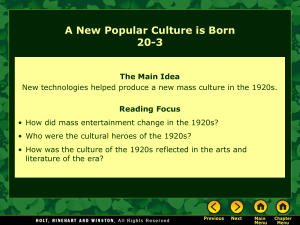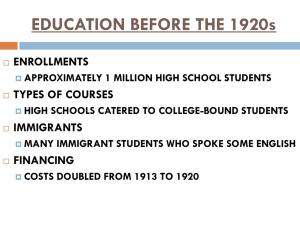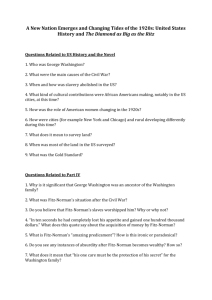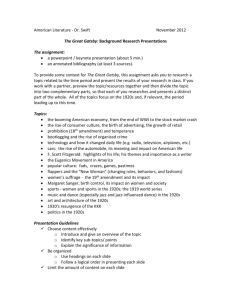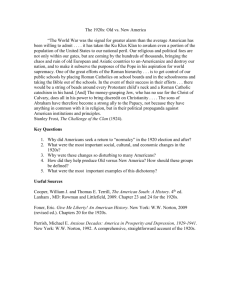10 - Ms. Arnold Social Studies
advertisement
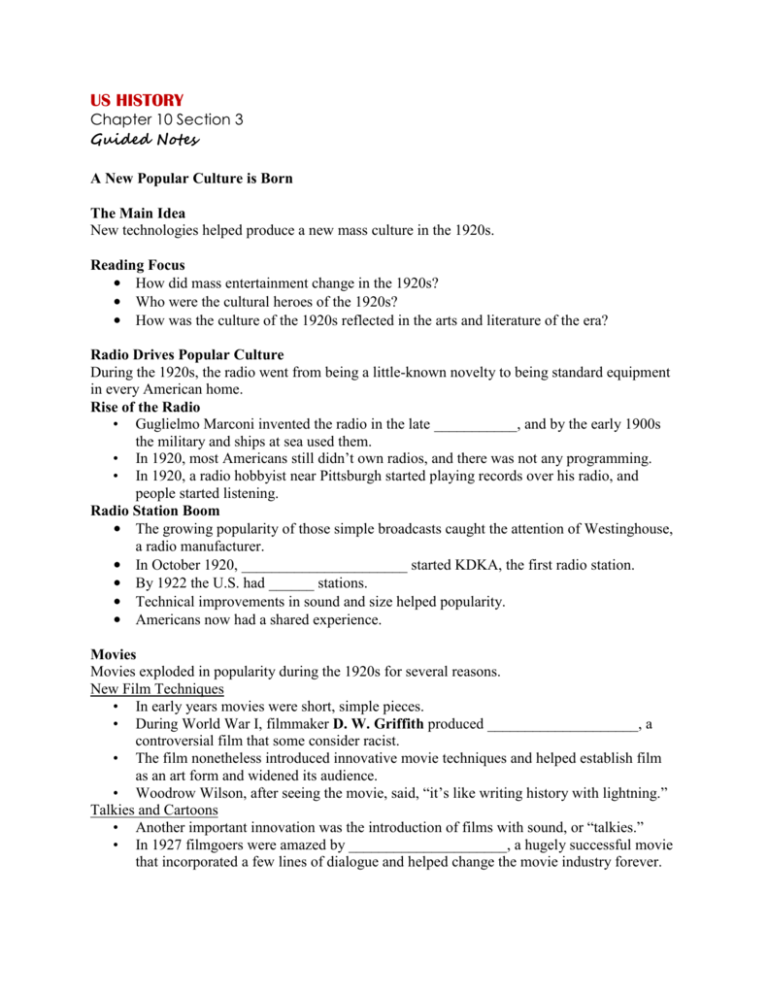
US HISTORY Chapter 10 Section 3 Guided Notes A New Popular Culture is Born The Main Idea New technologies helped produce a new mass culture in the 1920s. Reading Focus • How did mass entertainment change in the 1920s? • Who were the cultural heroes of the 1920s? • How was the culture of the 1920s reflected in the arts and literature of the era? Radio Drives Popular Culture During the 1920s, the radio went from being a little-known novelty to being standard equipment in every American home. Rise of the Radio • Guglielmo Marconi invented the radio in the late ___________, and by the early 1900s the military and ships at sea used them. • In 1920, most Americans still didn’t own radios, and there was not any programming. • In 1920, a radio hobbyist near Pittsburgh started playing records over his radio, and people started listening. Radio Station Boom • The growing popularity of those simple broadcasts caught the attention of Westinghouse, a radio manufacturer. • In October 1920, ______________________ started KDKA, the first radio station. • By 1922 the U.S. had ______ stations. • Technical improvements in sound and size helped popularity. • Americans now had a shared experience. Movies Movies exploded in popularity during the 1920s for several reasons. New Film Techniques • In early years movies were short, simple pieces. • During World War I, filmmaker D. W. Griffith produced ____________________, a controversial film that some consider racist. • The film nonetheless introduced innovative movie techniques and helped establish film as an art form and widened its audience. • Woodrow Wilson, after seeing the movie, said, “it’s like writing history with lightning.” Talkies and Cartoons • Another important innovation was the introduction of films with sound, or “talkies.” • In 1927 filmgoers were amazed by _____________________, a hugely successful movie that incorporated a few lines of dialogue and helped change the movie industry forever. • In 1928, the animated film ______________________ introduced _________________ and cartoons. By the end of the 1920s, Americans bought ___________________ movie tickets a week, though the entire U.S. population was about 123 million people. Film Star Heroes • The great popularity of movies in the 1920s gave rise to a new kind of celebrity—the movie star. • One of the brightest stars of the 1920s was ______________________, a comedian whose signature character was a tramp in a derby hat and ragged clothes. • Rudolph _____________________, a dashing leading man of romantic films, was such a big star that his unexpected death in 1926 drew tens of thousands of women to the funeral home where his body lay. • Clara Bow was a movie star nicknamed the “It Girl.” • Mary Pickford was considered “America’s Sweetheart” and was married to Douglas Fairbanks Jr., a major star of action films. • Their home, called “Pickfair,” was in Hollywood, the center of the motion picture industry. Pilot Heroes of the Twenties Charles Lindbergh • Charles Lindbergh was a daredevil pilot who practiced his skills as an airline pilot, a dangerous, life-threatening job at the time. • Lindbergh heard about a $25,000 prize for the first aviator to fly a nonstop ___________ flight, or a flight across the Atlantic Ocean, and wanted to win. • He rejected the idea that he needed a large plane with many engines, and developed a very light single-engine craft with room for only one pilot. • On May 21, _________, Lindbergh succeeded by touching down in Paris, France after a thirty-three-and-a-half-hour flight from New York. • Lindbergh earned the name “Lucky Lindy” and became the most beloved American hero of the time. Amelia Earhart • A little over a year after Lindbergh’s flight, Amelia Earhart became the first woman to fly across the Atlantic, returning to the U.S. as a hero. • She went on to set numerous speed and distance records as a pilot. • In ___________ she was most of the way through a record-breaking flight around the world when she disappeared over the Pacific Ocean. Sports Heroes Radio helped inflame the public passion for sports, and millions of Americans tuned in to broadcasts of ballgames and prize fights featuring their favorite athletes. ________________ __________________ Played powerful tennis, winning 31 College football player who earned major tournaments and two Olympic the nickname the “___________ gold medals. Her nerves of steel _________” for his speed. He turned earned her the nickname “Little professional after college, which Miss Poker Face.” was shocking at the time. _____________ ______________ Known as the “Sultan of Swat,” Jones won golf’s first Grand Slam, Ruth was legendary on the baseball meaning he won the game’s four field for his home runs. His legend major tournaments, and remains the lives on today in baseball circles and only golfer to get a Grand Slam for popular culture. matches in one calendar year. Arts of the 1920s • The great economic and social changes of the 1920s offered novelists a rich source of materials. • __________________________ helped create the flapper image, coined the term the “Jazz Age,” and explored the lives of the wealthy in ________________ and other novels and stories. • Sinclair Lewis wrote about the emptiness of middle-class life. • Edna St. Vincent Millay wrote poems on topics ranging from celebrations of youth to leading social causes of the day. • Willa Cather and Edith Wharton produced notable works of literature. • _______________________ and John Dos Passos were war veterans and, as part of the so-called _______________________, wrote about war experiences. • Gertrude Stein invented the term Lost Generation, referring to a group of writers who chose to live in Europe after World War I. • Bruce Barton’s novel compared Jesus to a modern business executive. • _________________________ was a composer best known for ____________________________—which showed the impact of jazz—as well as popular songs written with his brother Ira.
